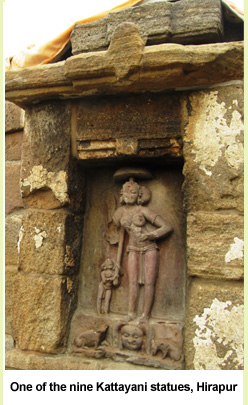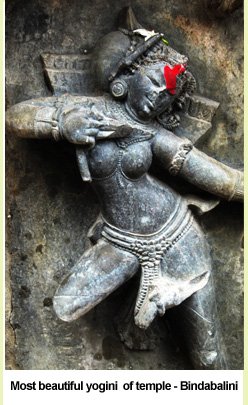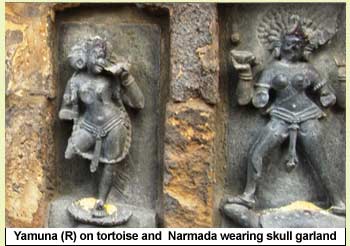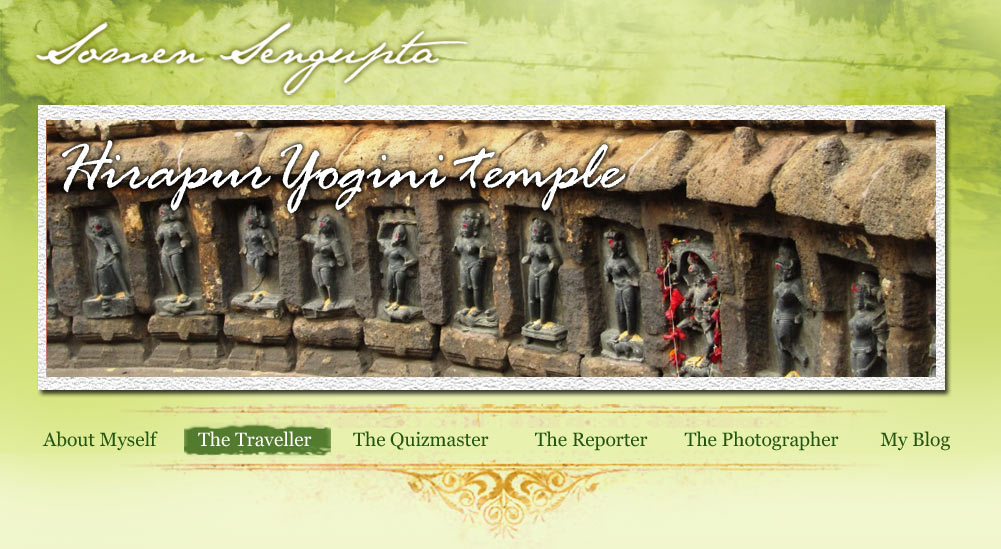|
At Hirapur in Orissa, a ninth century temple resonates with mesmerising silence and simultaneously speaks of its history through the rubble scattered around. Such is the magic of Choushatti Yogini temple, says Somen Sengupta
After crossing a narrow bridge over an dried up river, our car started negotiating with the bumpy road ahead. The little human habitation that the dusty area contains does not show any prosperity of Bhubaneswar town from where this place is hardly 15 km. I was searching for a small sandstone temple which is extraordinary and exceptional — both in its archaeology and origin.
At Hirapur, a ninth century temple resonates with mesmerising silence and simultaneously speaks of its history from every rubble scattered around. Such is the magic of the Choushatti Yogini temple.
The practice of worshiping a yogini is a part of a tantric cult that engulfed both Hinduism and Buddhism from the seventh century. Yogini temples that came up at a few places in Orissa, Uttar Pradesh and Madhya Pradesh in that era are the culmination of this cult. It was the time when necromancy and black magic became a supplement to worshipping Matrika or Mahamaya. As the dedicatory stone tablet is missing from the temple, the actual date and founder can never be known. However, it is assumed that the temple was built in the ninth century by the royal family of Somavansi who were worshippers of tantra. One figure of a yogini is missing. Local believe that the missing yogini is now worshipped in a village named Yamuna Kuda, but serious scholars of archaeology do not buy that.
The Choushatti Yogini temple was not known to the outside world till 1953. On January 24, 1953, Kedarnath Mohapatra, a famous archaeologist of Orissa, explored it while camping nearby. Based on information collected from local people who secretly practice necromancy, Mohapatra found a treasure of Indian archaeology. It was nothing but a coarse sandstone built circularly open to the sky; a temple with a 30 feet diameter and surrounded by an eight-feet high circular enclosure. He found 60 small fine-grained black chlorite stone statues carved in perfection and placed in the inner wall of the circular pavilion. He also found more statues in a chandi mandap inside the temple. They all represented female versions of many Hindu gods. This was just an amazing discovery and soon the Archaeological Survey of India (ASI) took over the temple.
As I march towards the temple, I saw the outer part of the enclosure first. It is not the yogini inside but the nine Kattayani statues that grabbed my attention. Collectively known as naba kattayani, these statues are made of light yellow sandstone. They are placed in various postures on the outer circular wall like sentinels of the temple just before the entrance. Some of them look like warriors.
It is amazing to note that all of these figures are standing on a male head accompanied by two or three animal figures like dogs or jackals. Their height varies between two feet six inches to two feet eleven inches.The first and last figures hold a weapon in their hands. Others hold decorative objectives. All the Kattayanis are well-dressed except the last one, which is nude.
In the courtyard, two sentinel figures known as Dwarpala are present. I carefully placed my head under a low roofed vestibule path to gain entry to the main temple. On both sides of the vestibule entrance, two defaced naked male images with their sunken bellies are found. Their bodies are emaciated. They sport skull garlands and there are some small figures around them who are equally devil looking, called Kala Bhairav and Bikala Bhairav.
They are carefully carved with exclusive distinction and every single female statue tells a story. Here most of the statues are either defaced or partly distorted, hinting at an attack by intolerant people.
 My attention was drawn towards the most exceptional yogini named Chamundi placed in niche 56. She was skull faced, showing her breast and rib bones. Standing in a trivanga dancing position, she sported a skull garland around her neck, and her face gave an expression of ruthlessness. The priest took me to niche 38 where I found Ganeshani, the female form of Ganesha. Defaced by barbarians, this elephant-headed figure is a replica of Ganesha statue. My attention was drawn towards the most exceptional yogini named Chamundi placed in niche 56. She was skull faced, showing her breast and rib bones. Standing in a trivanga dancing position, she sported a skull garland around her neck, and her face gave an expression of ruthlessness. The priest took me to niche 38 where I found Ganeshani, the female form of Ganesha. Defaced by barbarians, this elephant-headed figure is a replica of Ganesha statue.
Next to that stands the most beautiful yogini of the temple called Bindabalini. Mounted on a rat, this partly broken statue holds a bow and arrow. Her standing posture is more like that of a dancer than a warrior. At niche 26, stood a lion-faced female statue —the female version of Narshima. Worshipped as Singhamukhi, this figure has a unique hair style known as jatamandal and she holds a pot in her hands.
I saw Yamuna in niche 4. This four-handed female figure stands on a tortoise and holds a skull cup in her hand. Next to her is another yogini named Narmada. Surprisingly, she is wearing a skull garland and drinking blood from a human skull. In one of the niches, there is a figure with a musical instrument in her hands. Known as Saraswati, this four-handed figure stands on a snake. And she has a moustache too!
The biggest statue of the row is known as Mahamaya. This ten-armed image is sadly covered with clothes and metal ornaments placed by daily visitors. So, it’s archaeological beauty is no more visible. Being the biggest statue of this temple, this is the most famous among local people. In fact, the temple is known as Mahamaya temple and almost every day people offer flowers, oil and vermillion to it.
At the chandi mandapa, all the male bhairava statues are unique and interesting. They all are well-dressed but their genitals are exposed. All male statues are placed in such a way that they look directly at the yogini statues on the inner wall of the temple.
Of the four, a male statue has only one leg; he is known as ekapada bhairav. Mounted on a full bloom lotus, the figure is decorated with a head gear and has a weapon in hand. Next to this is another male figure with ten hands, seated in a vishwaopadmasa posture. His genital is also erected upwards and a man is found sleeping under his pedestal. Two more ten armed bhairavas are found near other pillars. Both are decorated with various gears and ornaments. While one statue in sleeping posture is found under one’s feet, another is found resting a leg on his lap.
The history of Orissa has witnessed the evolution of religious practices. Be it the oracle of Hinduism or entry of Vajrajana Buddhism and again the wave of Vaishnava cult, every saga left its footprint on the architecture of temples and monasteries. In that population, this temple stands isolated yet majestically. Its exceptional archaeology and religious expression is rare and adds a magical touch to the ambience.
Taken in by the temple’s beauty, I did not realise that the sun was slowly heading west and its golden rays were casting shadows on the walls of the temple. As I turned my back to the temple, I felt the same satisfaction that one can feel after dusting out a hidden gem.
This article was published on 10th August 2014 in The Pioneer
Click here to view the original article
|



